wiring MITSUBISHI iMiEV 2016 1.G Owners Manual
[x] Cancel search | Manufacturer: MITSUBISHI, Model Year: 2016, Model line: iMiEV, Model: MITSUBISHI iMiEV 2016 1.GPages: 296, PDF Size: 7.79 MB
Page 48 of 296
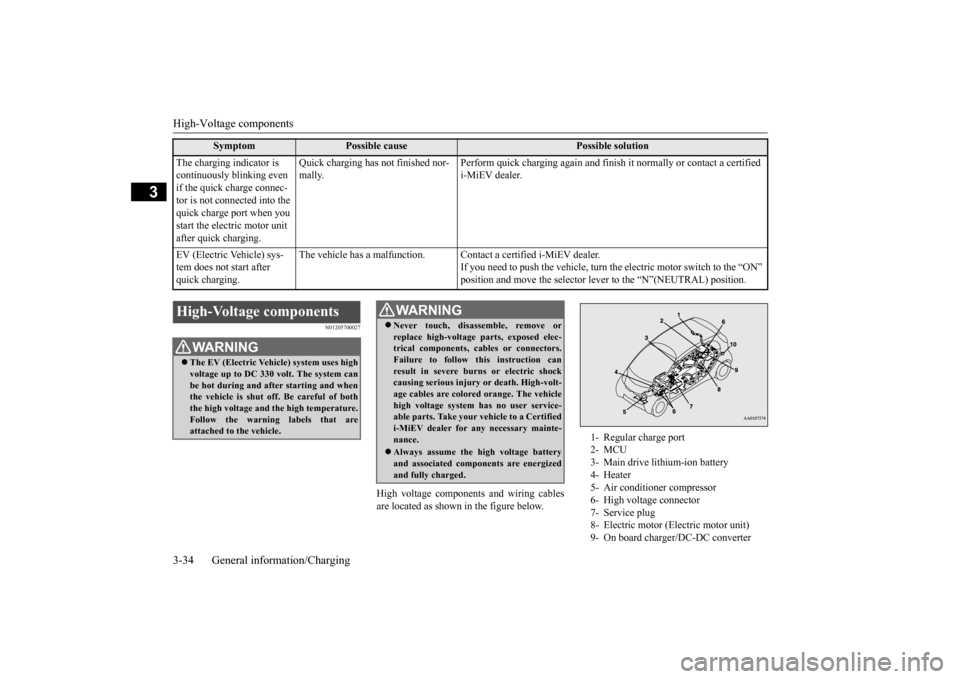
High-Voltage components 3-34 General information/Charging
3
N01205700027
High voltage components and wiring cables are located as shown in the figure below.
The charging indicator is continuously blinking even if the quick charge connec- tor is not connected into the quick charge port when you start the electric motor unit after quick charging.
Quick charging has not finished nor- mally.
Perform quick charging ag
ain and finish it normally
or contact a certified
i-MiEV dealer.
EV (Electric Vehicle) sys- tem does not start after quick charging.
The vehicle has a malfunction. Cont
act a certified i-MiEV dealer.
If you need to push the vehicle, turn the electric motor switch to the “ON”
lector lever to the
“N”(NEUTRAL) position.
Symptom
Possible cause
Possible solution
High-Voltage components
WA R N I N GThe EV (Electric Vehicle) system uses high voltage up to DC 330 volt. The system can be hot during and after starting and when the vehicle is shut off. Be careful of boththe high voltage and
the high temperature.
Follow the warning labels that are attached to the vehicle.
Never touch, disassemble, remove or replace high-voltage parts, exposed elec-trical components, cables or connectors. Failure to follow this instruction can result in severe burns or electric shockcausing serious injury
or death. High-volt-
age cables are colore
d orange. The vehicle
high voltage system has no user service-able parts. Take your
vehicle to a Certified
i-MiEV dealer for any necessary mainte- nance. Always assume the high voltage battery and associated components are energizedand fully charged.WA R N I N G
1- Regular charge port 2- MCU 3- Main drive lithium-ion battery 4- Heater5- Air conditioner compressor 6- High voltage connector 7- Service plug8- Electric motor (Electric motor unit) 9- On board charger/DC-DC converter
BK0220401US.book 34 ページ 2015年6月3日 水曜日 午前7時42分
Page 49 of 296
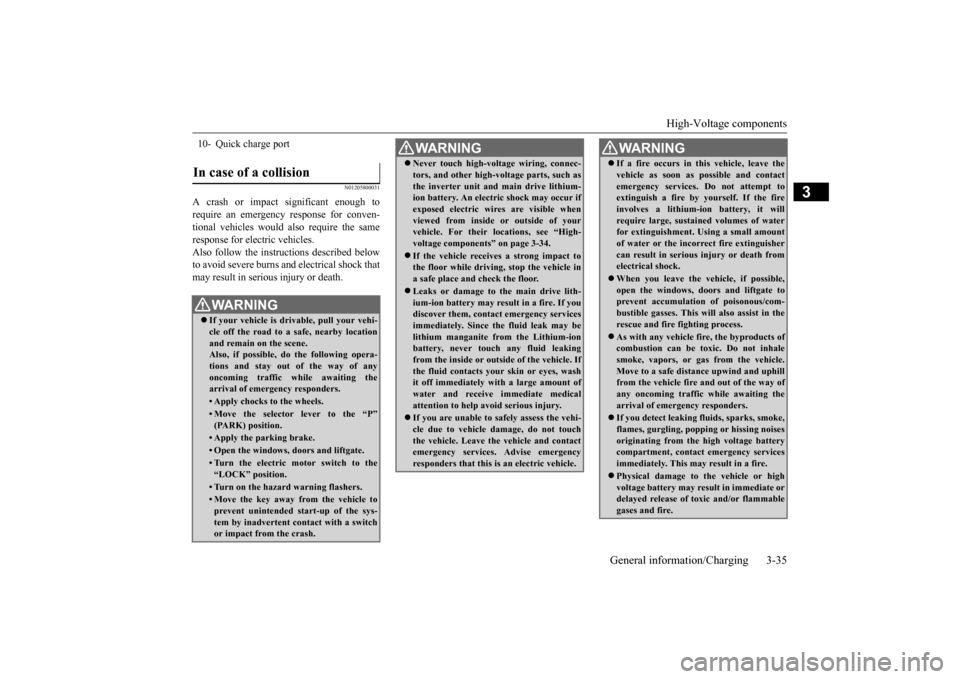
High-Voltage components
General information/Charging 3-35
3
N01205800031
A crash or impact significant enough to require an emergency response for conven- tional vehicles would
also require the same
response for electric vehicles. Also follow the instru
ctions described below
to avoid severe burns a
nd electrical shock that
may result in serious injury or death. 10- Quick charge portIn case of a collision
WA R N I N G If your vehicle is dri
vable, pull your vehi-
cle off the road to a safe, nearby locationand remain on the scene. Also, if possible, do the following opera- tions and stay out of the way of anyoncoming traffic while awaiting the arrival of emerge
ncy responders.
• Apply chocks to the wheels.• Move the selector
lever to the “P”
• Apply the parking brake.• Open the windows,
doors and liftgate.
• Turn the electric motor switch to the “LOCK” position.• Turn on the hazard warning flashers.• Move the key away from the vehicle to prevent unintended start-up of the sys- tem by inadvertent co
ntact with a switch
or impact from the crash.
Never touch high-voltage wiring, connec- tors, and other high-vol
tage parts, such as
the inverter unit and main drive lithium-ion battery. An electric shock may occur if exposed electric wires are visible when viewed from inside
or outside of your
vehicle. For their locations, see “High- voltage components” on page 3-34. If the vehicle receives a strong impact to the floor while driving, stop the vehicle in a safe place and check the floor. Leaks or damage to the main drive lith- ium-ion battery may result in a fire. If youdiscover them, contact emergency services immediately. Since the fluid leak may be lithium manganite from the Lithium-ionbattery, never touch any fluid leaking from the inside or outs
ide of the vehicle. If
the fluid contacts you
r skin or eyes, wash
it off immediately with a large amount of water and receive immediate medical attention to help
avoid serious injury.
If you are unable to safely assess the vehi- cle due to vehicle damage, do not touchthe vehicle. Leave the vehicle and contact emergency services. Advise emergency responders that this is
an electric vehicle.
WA R N I N G
If a fire occurs in th
is vehicle,
leave the
vehicle as soon as possible and contactemergency services. Do not attempt toextinguish a fire by yourself. If the fire involves a lithium-ion battery, it will require large, sustained volumes of waterfor extinguishment.
Using a small amount
of water or the incorrect fire extinguisher can result in serious injury or death fromelectrical shock. When you leave the ve
hicle, if possible,
open the windows,
doors and liftgate to
prevent accumulation of poisonous/com- bustible gasses. This will also assist in therescue and fire fighting process. As with any vehicle fi
re, the byproducts of
combustion can be toxic. Do not inhale smoke, vapors, or gas
from the vehicle.
Move to a safe distan
ce upwind and uphill
from the vehicle fire
and out of the way of
any oncoming traffic
while awaiting the
arrival of emerge
ncy responders.
If you detect leaking
fluids, sparks, smoke,
flames, gurgling, popp
ing or hissing noises
originating from the
high voltage battery
compartment, contact emergency services immediately. This may result in a fire. Physical damage to the vehicle or high voltage battery may result in immediate ordelayed release of t
oxic and/or flammable
gases and fire.WA R N I N G
BK0220401US.book 35 ページ 2015年6月3日 水曜日 午前7時42分
Page 50 of 296
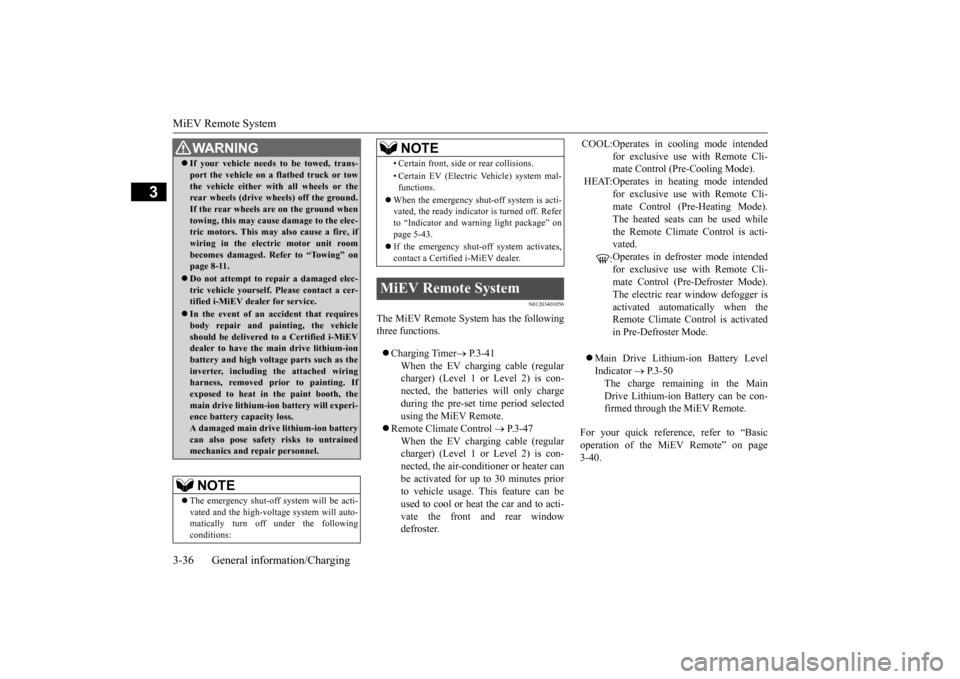
MiEV Remote System 3-36 General information/Charging
3
N01203401056
The MiEV Remote System has the following three functions. Charging Timer
P.3-41
When the EV charging cable (regular charger) (Level 1 or Level 2) is con-nected, the batteries will only charge during the pre-set
time period selected
using the MiEV Remote.
Remote Climate Control
P.3-47
When the EV charging cable (regular charger) (Level 1 or Level 2) is con-nected, the air-conditi
oner or heater can
be activated for up to 30 minutes prior to vehicle usage. This feature can beused to cool or heat the car and to acti- vate the front and rear window defroster.
Main Drive Lithium-ion Battery Level Indicator
P.3-50
The charge remaining in the Main Drive Lithium-ion Battery can be con-firmed through the MiEV Remote.
For your quick reference, refer to “Basic operation of the MiEV Remote” on page 3-40.
If your vehicle needs to be towed, trans- port the vehicle on a
flatbed truck or tow
the vehicle either with all wheels or therear wheels (drive
wheels) off the ground.
If the rear wheels are on the ground when towing, this may cause damage to the elec-tric motors. This may also cause a fire, if wiring in the electric motor unit room becomes damaged. Refer to “Towing” onpage 8-11. Do not attempt to repair a damaged elec- tric vehicle yourself. Please contact a cer- tified i-MiEV dealer for service. In the event of an ac
cident that requires
body repair and painting, the vehicle should be delivered
to a Certified i-MiEV
dealer to have the main drive lithium-ion battery and high voltage
parts such as the
inverter, including the attached wiringharness, removed prior to painting. If exposed to heat in the paint booth, the main drive lithium-ion battery will experi-ence battery capacity loss. A damaged main drive lithium-ion battery can also pose safety risks to untrainedmechanics and repair personnel.NOTE
The emergency shut-off
system will be acti-
vated and the high-volta
ge system will auto-
matically turn off under the following conditions:WA R N I N G
• Certain front, side or rear collisions. • Certain EV (Electric Vehicle) system mal- functions.
When the emergency shut
-off system is acti-
vated, the ready indicato
r is turned off. Refer
to “Indicator and warning light package” on page 5-43. If the emergency shut-off system activates, contact a Certifie
d i-MiEV dealer.
MiEV Remote System
NOTE
COOL:Operates in cooling mode intended
for exclusive use with Remote Cli- mate Control (P
re-Cooling Mode).
HEAT:Operates in heating mode intended
for exclusive use with Remote Cli- mate Control (P
re-Heating Mode).
The heated seats can be used while the Remote Climate Control is acti- vated. : Operates in defroster mode intended for exclusive use with Remote Cli- mate Control (Pre-Defroster Mode). The electric rear
window defogger is
activated automatically when theRemote Climate Control is activated in Pre-Defroster Mode.
BK0220401US.book 36 ページ 2015年6月3日 水曜日 午前7時42分
Page 85 of 296
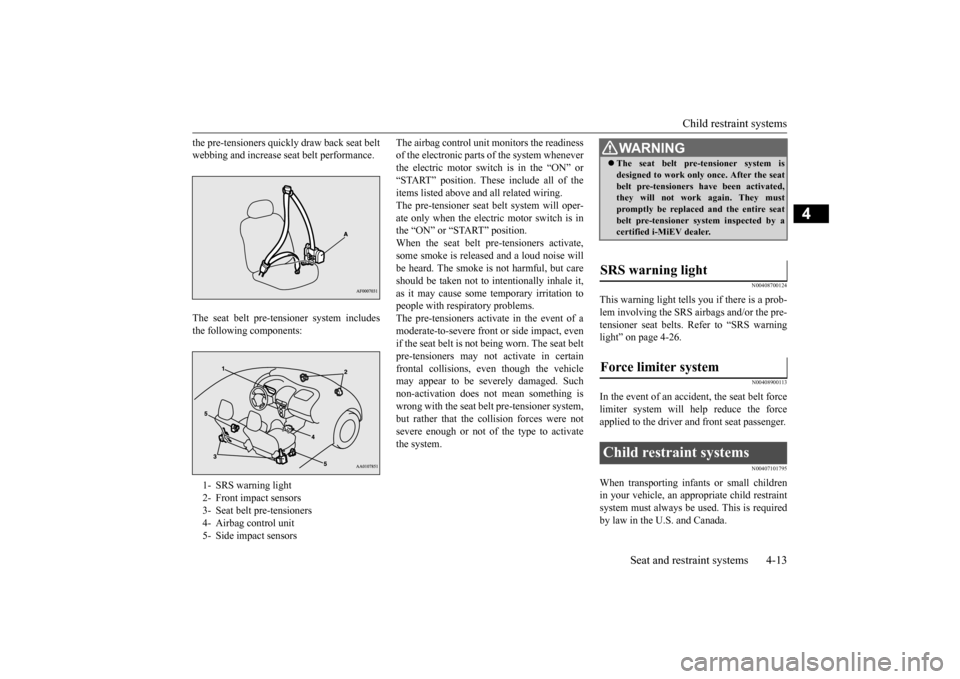
Child restraint systems
Seat and restraint systems 4-13
4
the pre-tensioners quickly
draw back seat belt
webbing and increase se
at belt performance.
The seat belt pre-tensioner system includes the following components:
The airbag control unit
monitors the readiness
of the electronic parts of the system wheneverthe electric motor switch is in the “ON” or “START” position. Thes
e include all of the
items listed above a
nd all related wiring.
The pre-tensioner seat
belt system will oper-
ate only when the electric motor switch is in the “ON” or “START” position.When the seat belt pre-tensioners activate, some smoke is released
and a loud noise will
be heard. The smoke is
not harmful, but care
should be taken not to in
tentionally inhale it,
as it may cause some
temporary irritation to
people with respiratory problems. The pre-tensioners activa
te in the event of a
moderate-to-severe front
or side impact, even
if the seat belt is not being worn. The seat belt pre-tensioners may not
activate in certain
frontal collisions, even though the vehiclemay appear to be se
verely damaged. Such
non-activation does not mean something is wrong with the seat belt pre-tensioner system,but rather that the collision forces were not severe enough or not of the type to activate the system.
N00408700124
This warning light tells you if there is a prob-lem involving the SRS airbags and/or the pre- tensioner seat belts. Refer to “SRS warning light” on page 4-26.
N00408900113
In the event of an accident, the seat belt forcelimiter system will help reduce the forceapplied to the driver a
nd front seat passenger.
N00407101795
When transporting infants or small children in your vehicle, an appr
opriate child restraint
system must always be
used. This is required
by law in the U.S. and Canada.
1- SRS warning light 2- Front impact sensors 3- Seat belt pr
e-tensioners
4- Airbag control unit 5- Side impact sensors
WA R N I N G The seat belt pre-tensioner system is designed to work only
once. After the seat
belt pre-tensioners have been activated,they will not work again. They must promptly be replaced and the entire seat belt pre-tensioner system inspected by acertified i-MiEV dealer.
SRS warning light Force limiter system Child restraint systems
BK0220401US.book 13 ページ 2015年6月3日 水曜日 午前7時42分
Page 95 of 296

Supplemental Restraint System (SRS) - airbag
Seat and restraint systems 4-23
4
N00407800489
The SRS includes the following components:
The airbag control unit
monitors the readiness
of the electronic parts of the system wheneverthe electric motor switch is in the “ON” or “START” position. Thes
e include all of the
items listed above a
nd all related wiring.
The airbags will operate only when the elec- tric motor switch is in the “ON” or “START” When the impact sensors detect a sufficient front or side impact to deploy the airbag(s),the appropriate airbag
(s) will be deployed.
When airbags deploy, some smoke is released accompanied by a loud noise. The smoke isnot harmful, but do not
intentionally inhale
the smoke as it may ca
use temporary irrita-
tion to people with respiratory problems. After deployment, the
airbags will quickly
deflate, so quickly th
at some people may not
even realize the airbags inflated. Airbag inflation does not prevent the driverfrom seeing or being able
to steer the vehicle,
and does not prevent people from leaving the vehicle.
N00418600227
This vehicle is equipped with an event data recorder (EDR). The main purpose of an EDR is to record, incertain crash or near
crash-like situations,
such as an airbag deployment or hitting a road obstacle, data that
will assist in under-
standing how a vehicl
e’s systems performed.
The EDR is designed to record data related to vehicle dynamics and safety systems for a
WA R N I N G Older children should be seated in the rear seat with their seat belt properlyworn, and with an
appropriate booster
seat if needed. Refer to “Children
who have outgrown
child restraint syst
ems” on page 4-19.
How the Supplemental Restraint System works 1- Driver’s airbag 2- SRS warning light 3- Passenger’s airb
ag off indicator
4- Front impact sensors5- Passenger’s front airbag 6- Driver’s seat position sensor
7- Passenger’s seat oc
cupant classifica-
tion sensor system
8- Airbag control unit 9- Side airbag modules 10- Curtain airbag modules 11- Side impact sensors
CAUTION Airbags inflate very quickly and with great force. In certain situations, contact with an inflating airbag may cause small cuts, abra- sions, and bruises.
Event Data Recording
BK0220401US.book 23 ページ 2015年6月3日 水曜日 午前7時42分
Page 106 of 296
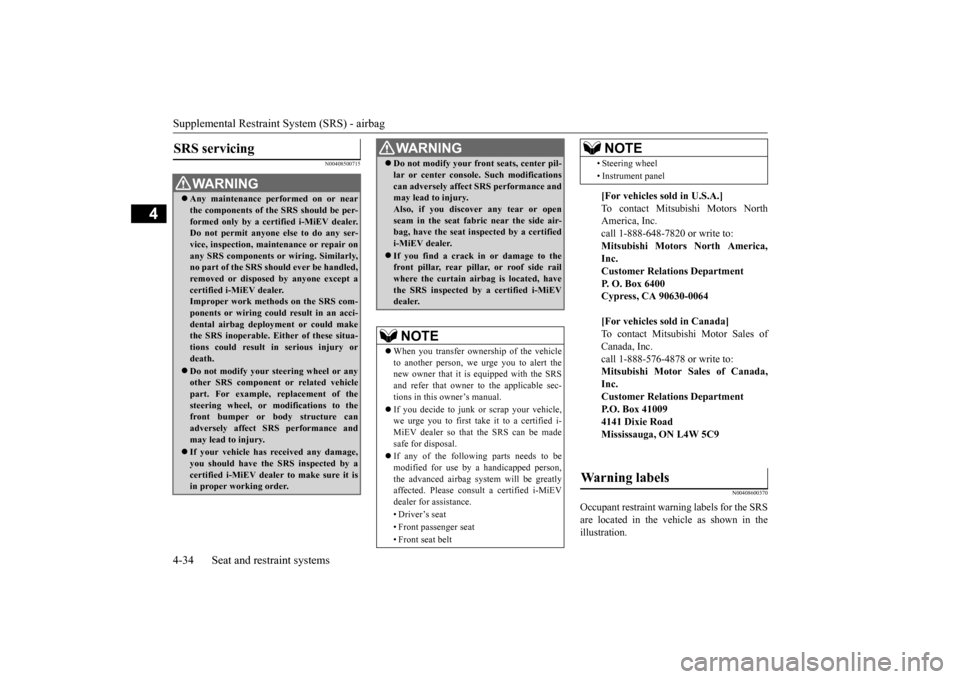
Supplemental Restraint System (SRS) - airbag 4-34 Seat and restraint systems
4
N00408500715
N00408600370
Occupant restraint warn
ing labels for the SRS
are located in the vehicle as shown in the illustration.
SRS servicing
WA R N I N G Any maintenance performed on or near the components of the SRS should be per-formed only by a certified i-MiEV dealer. Do not permit anyone else to do any ser- vice, inspection, main
tenance or repair on
any SRS components or
wiring. Similarly,
no part of the SRS should ever be handled, removed or disposed
by anyone except a
certified i-MiEV dealer. Improper work methods on the SRS com- ponents or wiring could result in an acci-dental airbag deploym
ent or could make
the SRS inoperable. Ei
ther of these situa-
tions could result in serious injury ordeath. Do not modify your steering wheel or any other SRS component
or related vehicle
part. For example, replacement of the steering wheel, or modifications to thefront bumper or body structure can adversely affect SR
S performance and
may lead to injury. If your vehicle has re
ceived any damage,
you should have the
SRS inspected by a
certified i-MiEV dealer to make sure it is in proper working order.
Do not modify your front seats, center pil- lar or center console. Such modificationscan adversely affect
SRS performance and
may lead to injury. Also, if you discove
r any tear or open
seam in the seat fabr
ic near the side air-
bag, have the seat in
spected by a certified
i-MiEV dealer. If you find a crack in
or damage to the
front pillar, rear pillar, or roof side rail where the curtain airbag is located, havethe SRS inspected by a certified i-MiEV dealer.NOTE
When you transfer ownership of the vehicle to another person, we
urge you to alert the
new owner that it is
equipped with the SRS
and refer that owner to
the applicable sec-
tions in this owner’s manual. If you decide to junk or scrap your vehicle, we urge you to first take it to a certified i- MiEV dealer so that the SRS can be madesafe for disposal. If any of the following parts needs to be modified for use by
a handicapped person,
the advanced airbag sy
stem will be greatly
affected. Please consult a certified i-MiEV dealer for assistance. •Driver’s seat • Front passenger seat • Front seat beltWA R N I N G
• Steering wheel • Instrument panel[For vehicles sold in U.S.A.] To contact Mitsubishi Motors North America, Inc.call 1-888-648-7820 or write to: Mitsubishi Motors North America, Inc.Customer Relations Department P. O. Box 6400 Cypress, CA 90630-0064 [For vehicles sold in Canada] To contact Mitsubishi Motor Sales ofCanada, Inc. call 1-888-576-4878 or write to: Mitsubishi Motor Sales of Canada,Inc. Customer Relations Department P.O. Box 410094141 Dixie Road Mississauga, ON L4W 5C9
Warning labels
NOTE
BK0220401US.book 34 ページ 2015年6月3日 水曜日 午前7時42分
Page 244 of 296
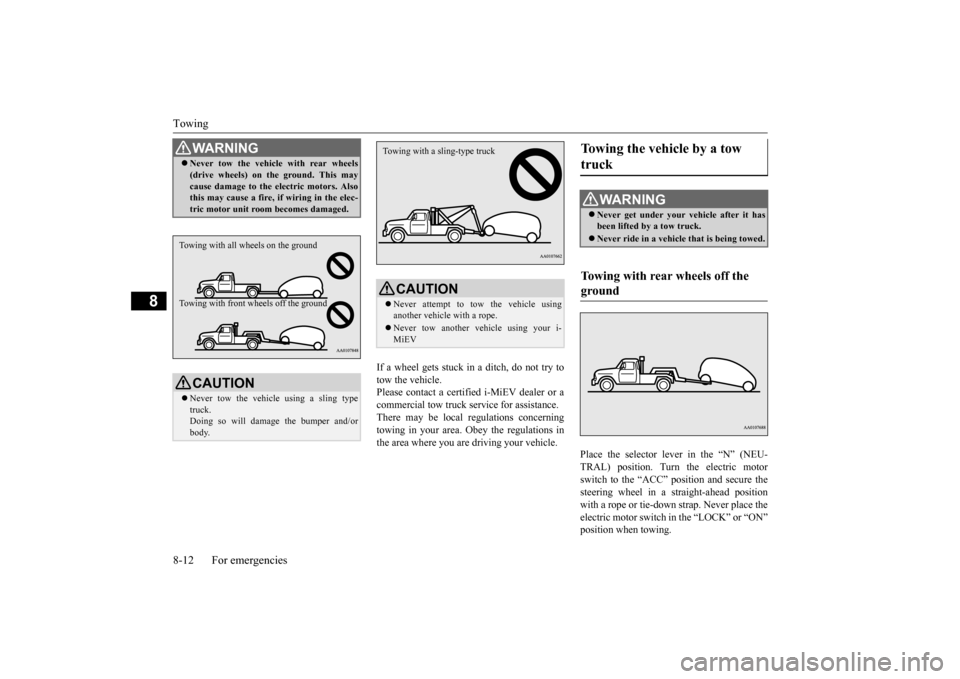
Towing 8-12 For emergencies
8
If a wheel gets stuck in
a ditch, do not try to
tow the vehicle. Please contact a certifie
d i-MiEV dealer or a
commercial tow truck service for assistance. There may be local re
gulations concerning
towing in your area. Obey the regulations inthe area where you are driving your vehicle.
Place the selector lever in the “N” (NEU- TRAL) position. Turn the electric motor switch to the “ACC” position and secure thesteering wheel in a st
raight-ahead position
with a rope or tie-down strap. Never place the electric motor switch in the “LOCK” or “ON”
WA R N I N G Never tow the vehicle with rear wheels (drive wheels) on th
e ground. This may
cause damage to the electric motors. Alsothis may cause a fire, if wiring in the elec- tric motor unit room becomes damaged.CAUTION Never tow the vehicl
e using a sling type
truck. Doing so will damage the bumper and/or body.Towing with all wheels on the ground Towing with front wheels off the ground
CAUTION Never attempt to tow the vehicle using another vehicle with a rope. Never tow another ve
hicle using your i-
MiEVTowing with a sling-type truck
Towing the vehicle by a tow truck
WA R N I N G Never get under your vehicle after it has been lifted by a tow truck. Never ride in a vehicl
e that is being towed.
Towing with rear wheels off the ground
BK0220401US.book 12 ページ 2015年6月3日 水曜日 午前7時42分
Page 248 of 296
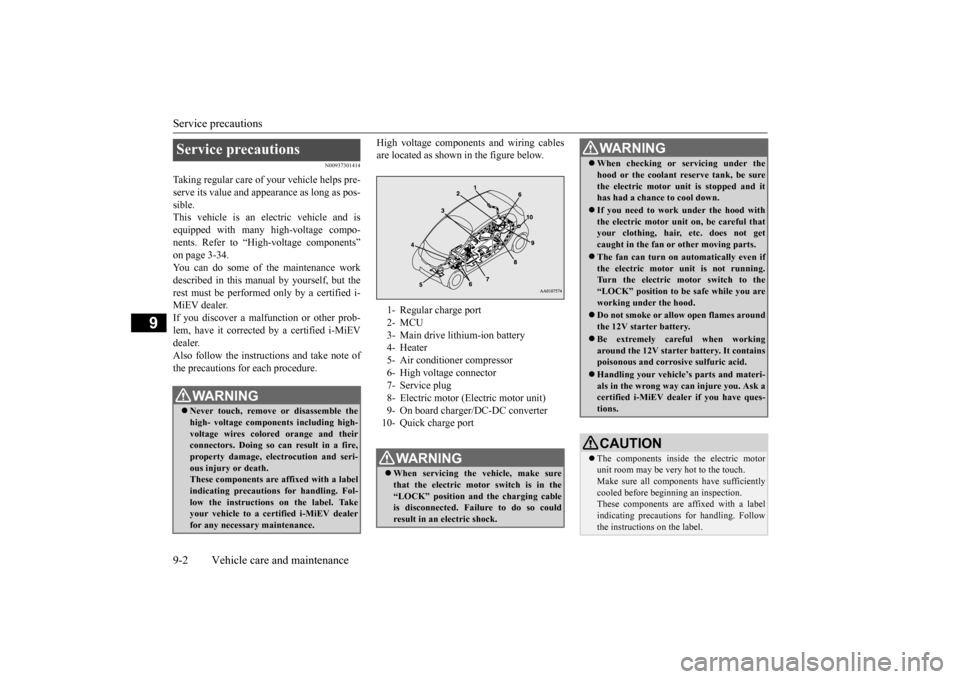
Service precautions 9-2 Vehicle care and maintenance
9
N00937301414
Taking regular care of your vehicle helps pre- serve its value and appe
arance as long as pos-
sible.This vehicle is an electric vehicle and is equipped with many high-voltage compo- nents. Refer to “High-voltage components”on page 3-34. You can do some of the maintenance work described in this manual by yourself, but the rest must be performed
only by a certified i-
MiEV dealer.If you discover a malfunction or other prob- lem, have it corrected by a certified i-MiEV dealer.Also follow the instru
ctions and take note of
the precautions for each procedure.
High voltage components and wiring cables are located as shown in the figure below.
Service precautions
WA R N I N G Never touch, remove or disassemble the high- voltage componen
ts including high-
voltage wires colore
d orange and their
connectors. Doing so can result in a fire, property damage, elec
trocution and seri-
ous injury or death. These components are affixed with a label indicating precautions for handling. Fol-low the instructions on the label. Take your vehicle to a cert
ified i-MiEV dealer
for any necessary maintenance.
1- Regular charge port 2- MCU 3- Main drive lithium-ion battery4- Heater 5- Air conditioner compressor 6- High voltage connector7- Service plug 8- Electric motor (Electric motor unit)10- Quick charge port
WA R N I N G When servicing the vehicle, make sure that the electric motor switch is in the“LOCK” position and
the charging cable
is disconnected. Failure to do so could result in an electric shock.
When checking or servicing under the hood or the coolant reserve tank, be surethe electric motor unit is stopped and ithas had a chance to cool down. If you need to work
under the hood with
the electric motor unit on, be careful that your clothing, hair, etc. does not get caught in the fan or other moving parts. The fan can turn on automatically even if the electric motor unit is not running.Turn the electric motor switch to the “LOCK” position to be
safe while you are
working under the hood. Do not smoke or allow open flames around the 12V starter battery. Be extremely careful when working around the 12V starter battery. It containspoisonous and corros
ive sulfuric acid.
Handling your vehicle’s parts and materi- als in the wrong way can injure you. Ask a certified i-MiEV dealer
if you have ques-
tions. CAUTION The components inside
the electric motor
unit room may be very
hot to the touch.
Make sure all components have sufficientlycooled before beginning an inspection. These components are affixed with a label indicating precautions
for handling. Follow
the instructions on the label.WA R N I N G
BK0220401US.book 2 ページ 2015年6月3日 水曜日 午前7時42分
Page 267 of 296
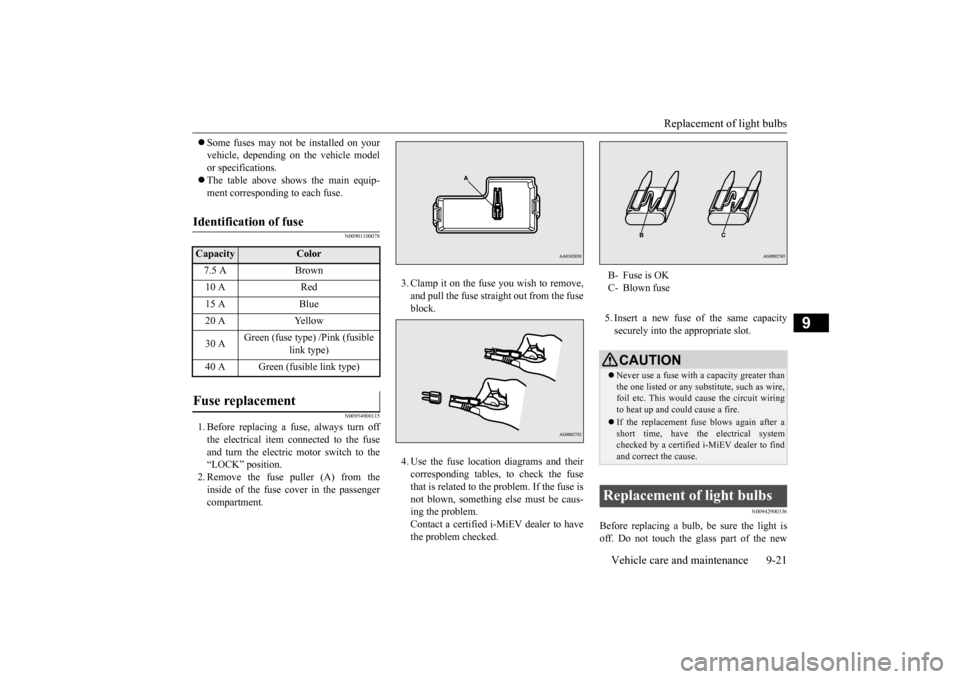
Replacement of light bulbs
Vehicle care and maintenance 9-21
9
Some fuses may not be installed on your vehicle, depending on
the vehicle model
or specifications. The table above show
s the main equip-
ment corresponding to each fuse.
N00901100078 N00954900115
1. Before replacing a fuse, always turn off the electrical item connected to the fuse and turn the electric motor switch to the “LOCK” position.2. Remove the fuse puller (A) from the inside of the fuse cover in the passenger compartment.
3. Clamp it on the fuse you wish to remove, and pull the fuse straight out from the fuseblock. 4. Use the fuse location diagrams and their corresponding tables, to check the fuse that is related to the problem. If the fuse is not blown, something
else must be caus-
ing the problem.Contact a certified i-MiEV dealer to have the problem checked.
5. Insert a new fuse of the same capacity securely into the appropriate slot.
N00942900336
Before replacing a bulb,
be sure the light is
off. Do not touch the glass part of the new
Identification of fuse Capacity
Color
7.5 A Brown 10 A Red 15 A Blue 20 A Yellow 30 A
Green (fuse type) /Pink (fusible
link type)
40 A Green (fusible link type)
Fuse replacement
B- Fuse is OK C- Blown fuseCAUTION Never use a fuse with a capacity greater than the one listed or any substitute, such as wire, foil etc. This would
cause the circuit wiring
to heat up and could cause a fire. If the replacement fuse blows again after a short time, have the electrical systemchecked by a certified i-MiEV dealer to find and correct the cause.
Replacement of light bulbs
BK0220401US.book 21 ページ 2015年6月3日 水曜日 午前7時42分